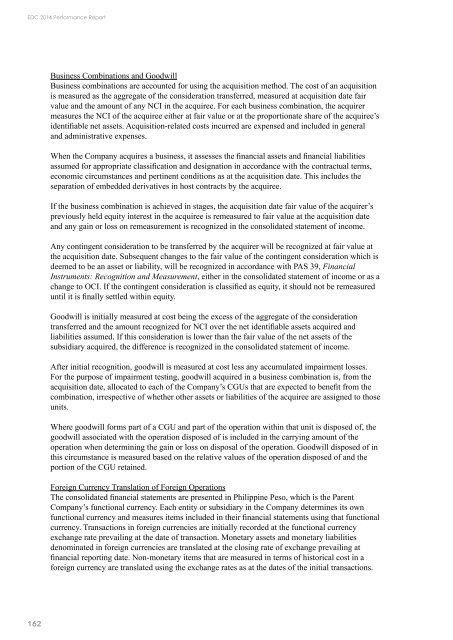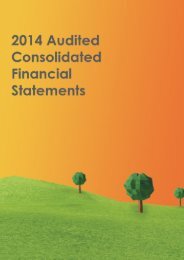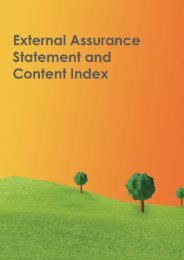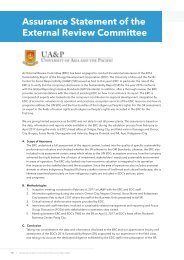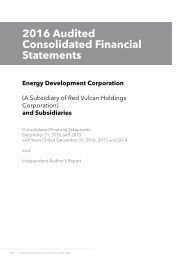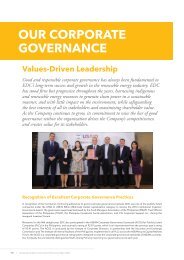EDC 2014 SR (UPDATED)
You also want an ePaper? Increase the reach of your titles
YUMPU automatically turns print PDFs into web optimized ePapers that Google loves.
<strong>EDC</strong> <strong>2014</strong> Performance Report<br />
Business Combinations and Goodwill<br />
Business combinations are accounted for using the acquisition method. The cost of an acquisition<br />
is measured as the aggregate of the consideration transferred, measured at acquisition date fair<br />
value and the amount of any NCI in the acquiree. For each business combination, the acquirer<br />
measures the NCI of the acquiree either at fair value or at the proportionate share of the acquiree’s<br />
identifiable net assets. Acquisition-related costs incurred are expensed and included in general<br />
and administrative expenses.<br />
When the Company acquires a business, it assesses the financial assets and financial liabilities<br />
assumed for appropriate classification and designation in accordance with the contractual terms,<br />
economic circumstances and pertinent conditions as at the acquisition date. This includes the<br />
separation of embedded derivatives in host contracts by the acquiree.<br />
If the business combination is achieved in stages, the acquisition date fair value of the acquirer’s<br />
previously held equity interest in the acquiree is remeasured to fair value at the acquisition date<br />
and any gain or loss on remeasurement is recognized in the consolidated statement of income.<br />
Any contingent consideration to be transferred by the acquirer will be recognized at fair value at<br />
the acquisition date. Subsequent changes to the fair value of the contingent consideration which is<br />
deemed to be an asset or liability, will be recognized in accordance with PAS 39, Financial<br />
Instruments: Recognition and Measurement, either in the consolidated statement of income or as a<br />
change to OCI. If the contingent consideration is classified as equity, it should not be remeasured<br />
until it is finally settled within equity.<br />
Goodwill is initially measured at cost being the excess of the aggregate of the consideration<br />
transferred and the amount recognized for NCI over the net identifiable assets acquired and<br />
liabilities assumed. If this consideration is lower than the fair value of the net assets of the<br />
subsidiary acquired, the difference is recognized in the consolidated statement of income.<br />
After initial recognition, goodwill is measured at cost less any accumulated impairment losses.<br />
For the purpose of impairment testing, goodwill acquired in a business combination is, from the<br />
acquisition date, allocated to each of the Company’s CGUs that are expected to benefit from the<br />
combination, irrespective of whether other assets or liabilities of the acquiree are assigned to those<br />
units.<br />
Where goodwill forms part of a CGU and part of the operation within that unit is disposed of, the<br />
goodwill associated with the operation disposed of is included in the carrying amount of the<br />
operation when determining the gain or loss on disposal of the operation. Goodwill disposed of in<br />
this circumstance is measured based on the relative values of the operation disposed of and the<br />
portion of the CGU retained.<br />
Foreign Currency Translation of Foreign Operations<br />
The consolidated financial statements are presented in Philippine Peso, which is the Parent<br />
Company’s functional currency. Each entity or subsidiary in the Company determines its own<br />
functional currency and measures items included in their financial statements using that functional<br />
currency. Transactions in foreign currencies are initially recorded at the functional currency<br />
exchange rate prevailing at the date of transaction. Monetary assets and monetary liabilities<br />
denominated in foreign currencies are translated at the closing rate of exchange prevailing at<br />
financial reporting date. Non-monetary items that are measured in terms of historical cost in a<br />
foreign currency are translated using the exchange rates as at the dates of the initial transactions.<br />
162


